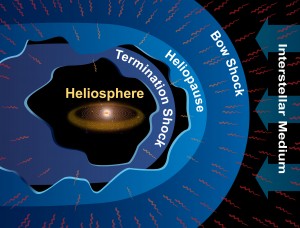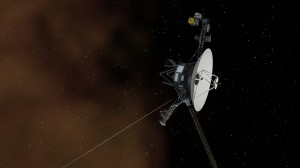23 July 2014
WASHINGTON, D.C. — In 2012, the Voyager mission team announced that the Voyager 1 spacecraft had passed into interstellar space, traveling further from Earth than any other manmade object.
But, in the nearly two years since that historic announcement, and despite subsequent observations backing it up, uncertainty about whether Voyager 1 really crossed the threshold continues. There are some scientists who say that the spacecraft is still within the heliosphere – the region of space dominated by the Sun and its wind of energetic particles – and has not yet reached the space between the stars.
Now, two Voyager team scientists have developed a test that they say could prove once and for all if Voyager 1 has crossed the boundary. The new test is outlined in a study accepted for publication in Geophysical Research Letters, a journal of the American Geophysical Union.
The scientists predict that, in the next two years, Voyager 1 will cross the current sheet – the sprawling surface within the heliosphere where the polarity of the sun’s magnetic field changes from plus to minus. The spacecraft will detect a reversal in the magnetic field, proving that it is still within the heliosphere. But, if the magnetic field reversal doesn’t happen in the next year or two as expected, that is confirmation that Voyager 1 has already passed into interstellar space.

The heliosphere, in which the Sun and planets reside, is a large bubble inflated from the inside by the high-speed solar wind blowing out from the Sun. Pressure from the solar wind, along with pressure from the surrounding interstellar medium, determines the size and shape of the heliosphere. The supersonic flow of solar wind abruptly slows at the termination shock, the innermost boundary of the solar system. The edge of the solar system is the heliopause. The bow shock pushes ahead through the interstellar medium as the heliosphere plows through the galaxy.
Credit: Southwest Research Institute
“The proof is in the pudding,” said George Gloeckler, a professor in atmospheric, oceanic and space sciences at the University of Michigan in Ann Arbor and lead author of the new study.
Gloeckler has worked on the Voyager mission since 1972 and has been a vocal opponent of the view that Voyager 1 has entered interstellar space. He said that, although the spacecraft has observed many of the signs indicating it may have reached interstellar space, like cosmic rays, Voyager 1 did not see a change in magnetic field that many were expecting.
“This controversy will continue until it is resolved by measurements,” Gloeckler said.
If the new prediction is right, “this will be the highlight of my life,” he said. “There is nothing more gratifying than when you have a vision or an idea and you make a prediction and it comes true.”
The Voyager 1 and 2 spacecraft were launched in 1977 to study Jupiter and Saturn. The mission has since been extended to explore the outermost limits of the Sun’s influence and beyond. Voyager 2, which also flew by Uranus and Neptune, is on its way to interstellar space.
Gloeckler and co-author, Len Fisk, also a professor in atmospheric, oceanic and space sciences at the University of Michigan, are basing their new test on a model they developed and published earlier this year in The Astrophysical Journal. The model assumes that the solar wind is slowing down and, as a result, that the solar wind can be compressed. Based on this assumption, the study says Voyager 1 is moving faster than the outward flow of the solar wind and will encounter current sheets where the polarity of the magnetic field will reverse, proving that the spacecraft has not yet left the heliosphere. The scientists predict this reversal will most likely happen during 2015, based on observations made by Voyager 1.
“If that happens, I think if anyone still believes Voyager 1 is in the interstellar medium, they will really have something to explain,” Gloeckler said. “It is a signature that can’t be missed.”
Ed Stone of the California Institute of Technology in Pasadena and NASA’s Voyager Project Scientist said in a statement that “It is the nature of the scientific process that alternative theories are developed in order to account for new observations. This paper differs from other models of the solar wind and the heliosphere and is among the new models that the Voyager team will be studying as more data are acquired by Voyager.”
Alan Cummings, a senior research scientist at California Institute of Technology in Pasadena and a co-investigator on the Voyager mission, believes Voyager 1 has most likely crossed into interstellar space, but he said there is a possibility that Gloeckler and Fisk are right and the spacecraft is still in the heliosphere. He said that if Voyager 1 experiences a current sheet crossing like the one being proposed in the new study, it could also mean that the heliosphere is expanding and crossed the spacecraft again.
“If the magnetic field had cooperated, I don’t think we’d be having this discussion,” Cummings said. “This is a puzzle. It is very reasonable to explore alternate explanations. We don’t understand everything that happened out there.”
Stephen Fuselier, director of the space science department at the Southwest Research Institute in San Antonio, Texas, who is not involved with the research and is not on the Voyager 1 team, said the scientists have come up with a good test to prove once and for all if Voyager 1 has crossed into interstellar space. However, he does not agree with the assumption that the paper is making about the how fast the solar wind is moving. But, he said there is no way to measure this flow velocity, and if Gloeckler and Fisk’s assumptions are correct, the model makes sense and Voyager 1 could still be inside the heliosphere.

This artist’s concept shows the Voyager 1 spacecraft entering the space between stars. The Voyager mission team announced in 2012 that the Voyager 1 spacecraft had passed into interstellar space, but some scientists say it is still within the heliosphere – the region of space domininated by the Sun and its wind of energetic particles. In a new study, two Voyager team scientists are proposing a test that they say could prove once and for all of Voyager 1 has crossed the boundary.
Credit: NASA/JPL-Caltech
“I applaud them for coming out with a bold prediction,” said Fuselier, who works on the Interstellar Boundary Explorer mission that is examining the boundary between the solar wind and the interstellar medium. “If they are right, they are heroes. If they are wrong, though, it is important for the community to understand why … If they are wrong, then that must mean that one or more of their assumptions is incorrect, and we as a community have to understand which it is.”
Fuselier, who believes Voyager 1 has entered interstellar space, said he will reserve judgment on whether Gloecker and Fisk are correct until 2016. He said there is a sizeable fraction of the space community that is skeptical that Voyager 1 has entered interstellar space, but the new proposed test could help end that debate. Another good test will come when Voyager 2 crosses into interstellar space in the coming years, Fuselier and Cummings said.
“If you go back 10 years and talk to the Voyager people, they would have told you 10 years ago that what they would see upon exiting the heliosphere is very, very different from what they are seeing now,” Fuselier said. “We are just loaded down with surprises and this might be one of them.”
###
The American Geophysical Union is dedicated to advancing the Earth and space sciences for the benefit of humanity through its scholarly publications, conferences, and outreach programs. AGU is a not-for-profit, professional, scientific organization representing more than 62,000 members in 144 countries. Join our conversation on Facebook, Twitter, YouTube, and other social media channels.
Notes for Journalists
Journalists and public information officers (PIOs) of educational and scientific institutions who have registered with AGU can download a PDF copy of this accepted article by clicking on this link: http://onlinelibrary.wiley.com/doi/10.1002/2014GL060781/abstract?campaign=wolacceptedarticle
Or, you may order a copy of the final paper by emailing your request to Peter Weiss at [email protected]. Please provide your name, the name of your publication, and your phone number.
Neither the paper nor this press release is under embargo.
“A test for whether or not Voyager 1 has crossed the heliopause”
Authors:
G. Gloeckler and L.A. Fisk: Department of Atmospheric, Oceanic and Space Sciences, University of Michigan, Ann Arbor, Michigan, USA.
Contact information for the authors:
Lennard Fisk: +1 (734) 763-8184, [email protected]
George Gloeckler: +1 (303) 249-0667, [email protected]
Peter Weiss
+1 (202) 777-7507
[email protected]
University of Michigan Contact:
Allison Lyons
+1 (734) 764-5235
[email protected]